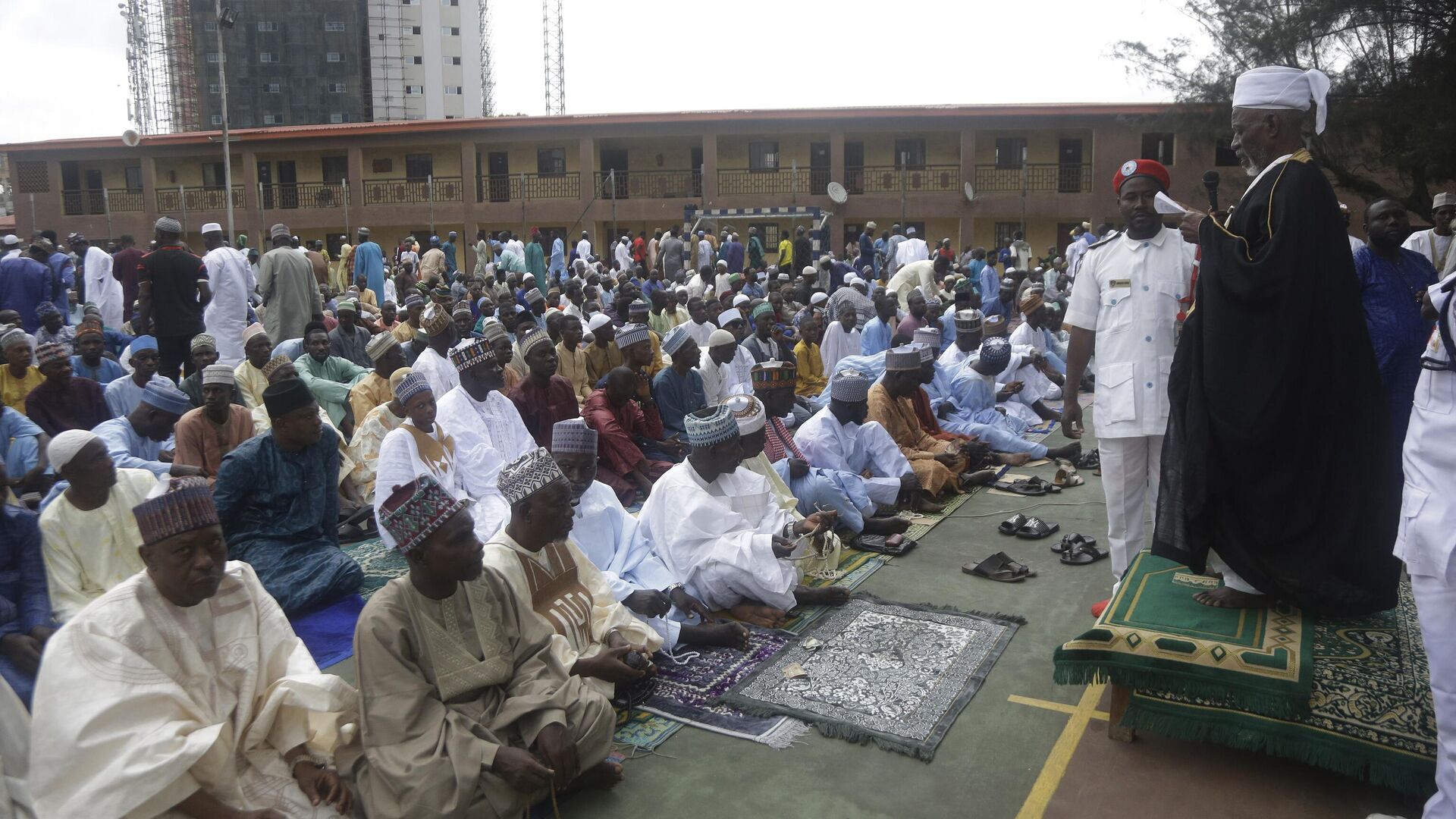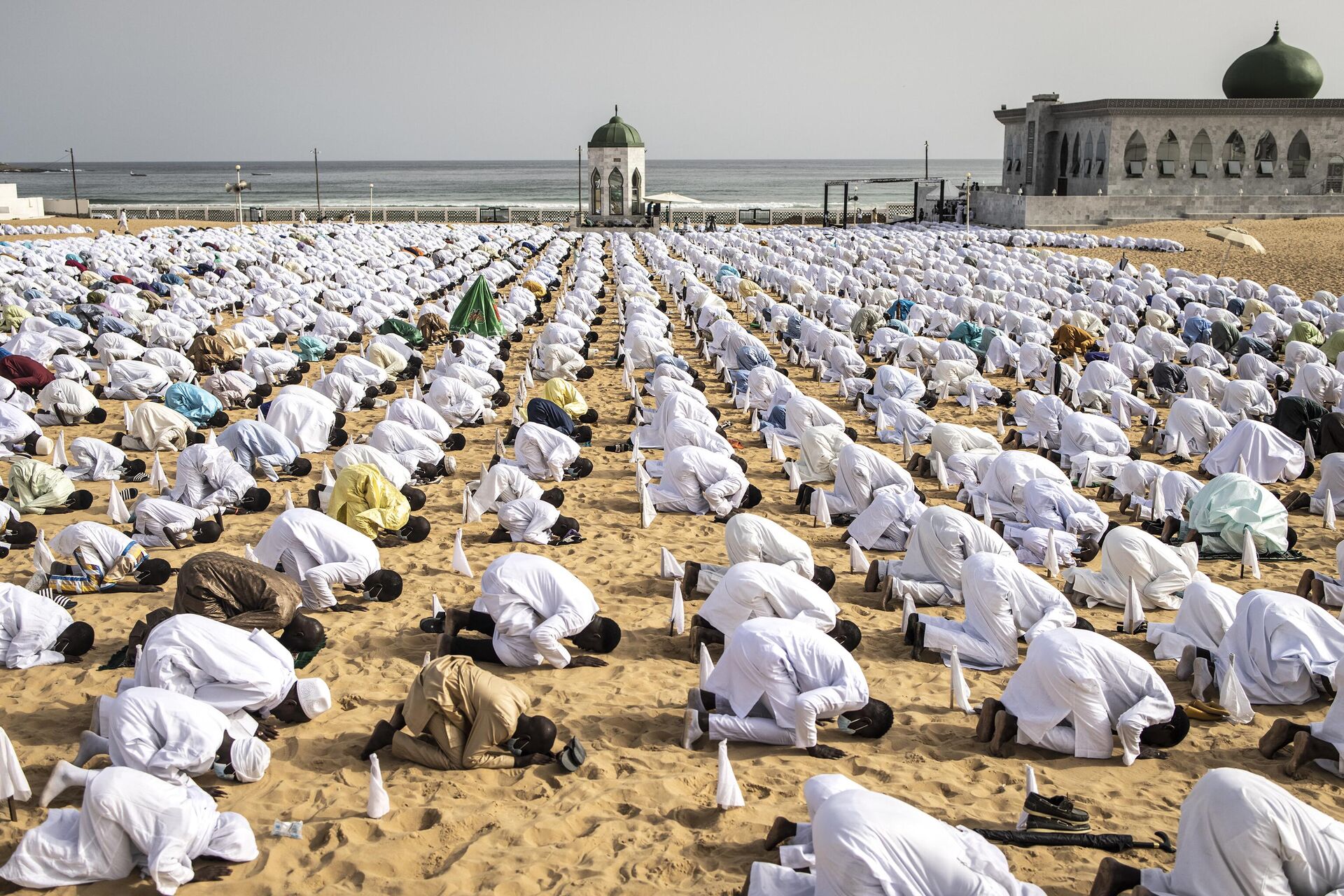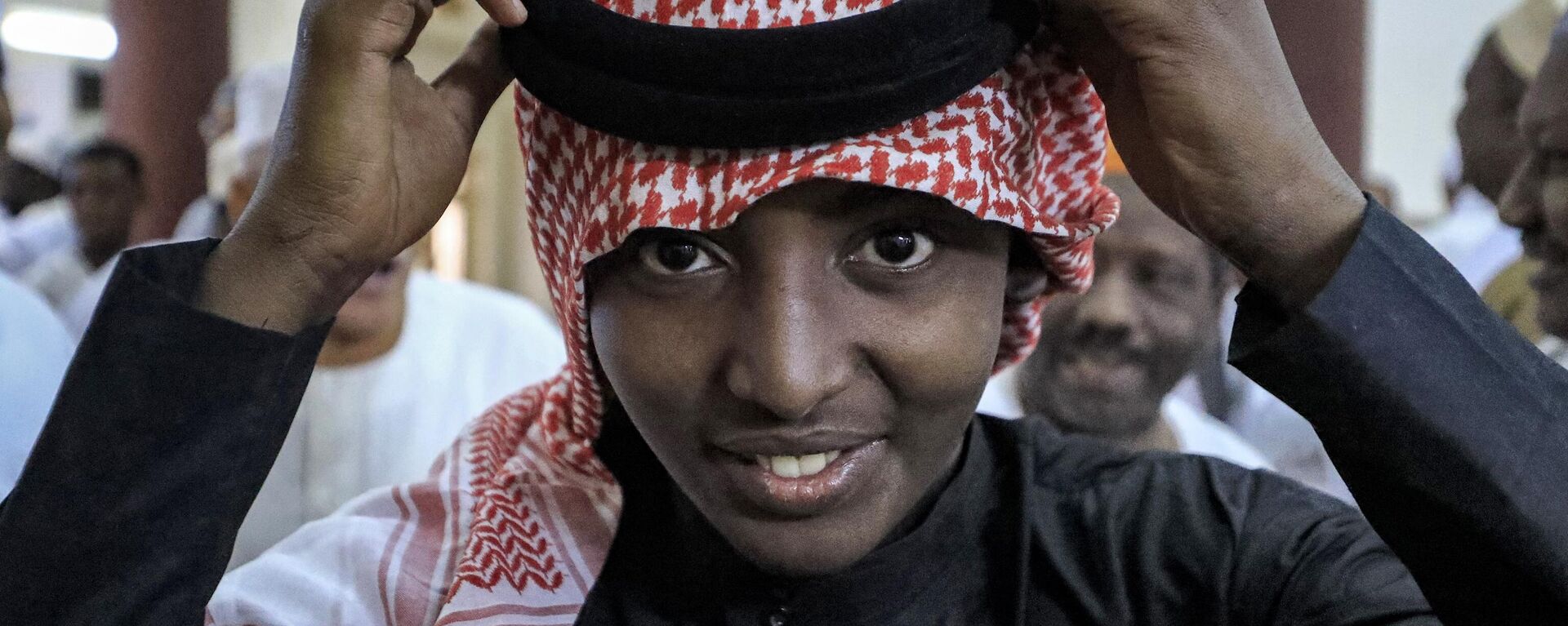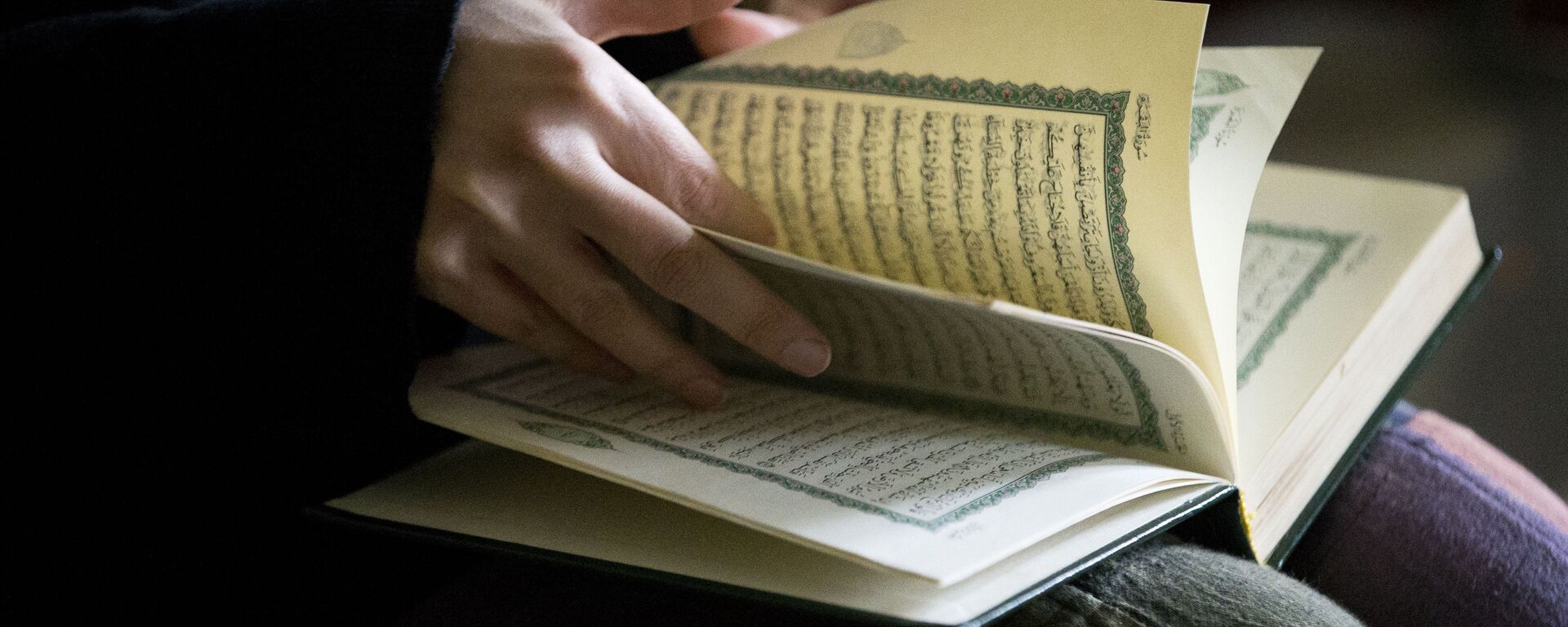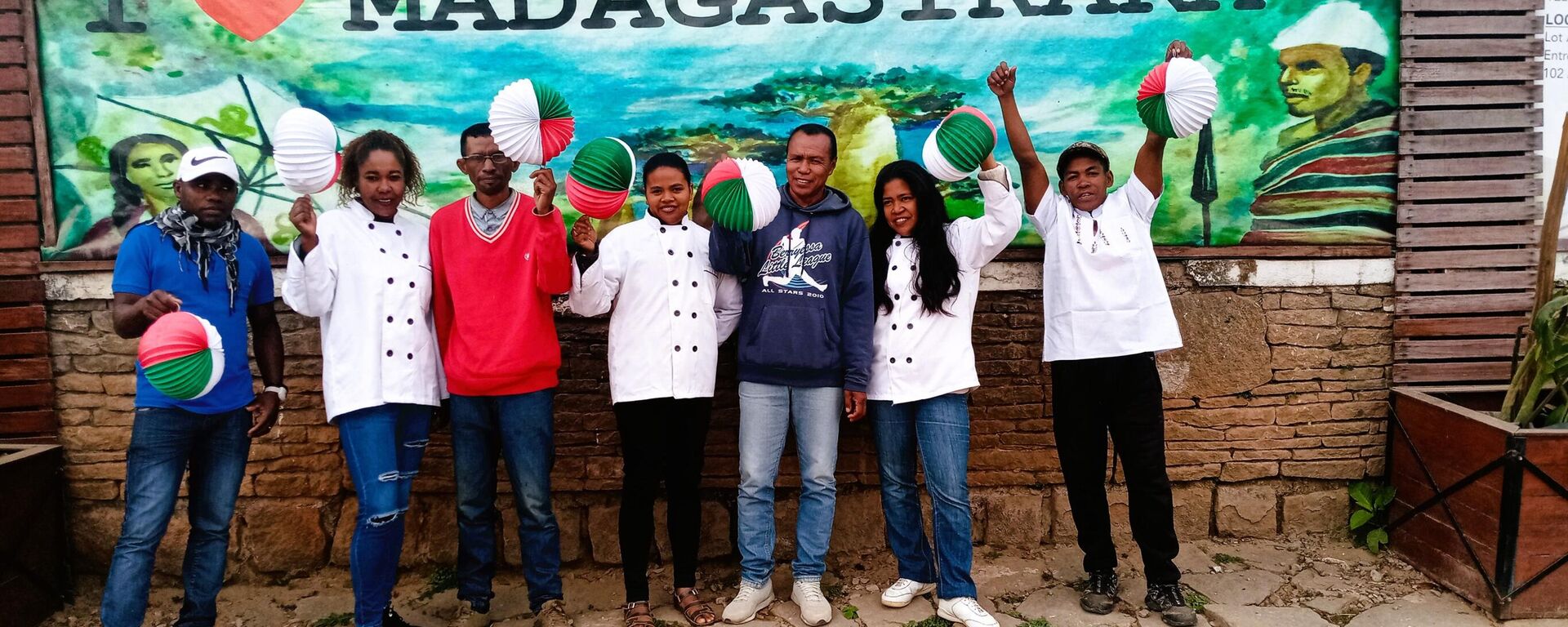https://en.sputniknews.africa/20230627/commemorating-the-sacrifice-how-african-muslims-celebrate-eid-al-adha-1060167481.html
Commemorating the Sacrifice: How African Muslims Celebrate Eid al-Adha
Commemorating the Sacrifice: How African Muslims Celebrate Eid al-Adha
Sputnik Africa
Eid al-Adha or the Feast of Sacrifice is one of the holidays celebrated by Muslims all over the world on the 10th day of Dhu al-Hijja, the final month in the... 27.06.2023, Sputnik Africa
2023-06-27T08:17+0200
2023-06-27T08:17+0200
2023-06-27T10:02+0200
features
holidays
eid al-adha
islam
nigeria
ghana
senegal
madagascar
charity
muslims
https://cdn1.img.sputniknews.africa/img/07e7/06/1a/1060173421_0:160:3072:1888_1920x0_80_0_0_aaefd235cf6d6f34f3a49c39ba5392d8.jpg
Eid al-Adha is one of the most sacred holidays in Islam. Muslims all around the globe join in on celebrations to commemorate and honor the sacrifice that Prophet Ibrahim made as a manifestation of his submission to the will of God. According to the story, his faith and devotion to Allah was tested when he was commanded to sacrifice his son, Ishmael.Even though his only son was bestowed upon him at a very old age, Ibrahim was ready to obey the order and slaughter his beloved son as an act of faith and obedience to God. However, at the very point of sacrifice, Allah replaced Ishmael with a lamb. Prophet Ibrahim developed such an exceptional spirit of sacrifice that Allah urged all Muslims to set aside a special day for the commemoration of his dedication and faith. Therefore, Eid al-Adha means the "festival of sacrifice". One of the main parts of the celebrations involves animal sacrifices. Part of the meat is consumed by a family that offers an animal, while the rest is donated to the poor and people in need. During days of celebrations, Muslims typically visit relatives, or share sweets and gifts. The high point of the celebration is the conclusion of the annual pilgrimage to Mecca, Saudi Arabia, known as Hajj.Even though Eid al-Adha is observed across the world, there are subtle differences in the manner of celebrations from place to place. Most of the religious rites are universally the same. However, many nations and communities have their own special ways of celebrating.Africa is home to about 446 million people who follow the Islamic faith, almost half of the continent's population. The majority of Muslims live in North, West, and East Africa. As most of the African nations are set to start great celebrations of the Feast of Sacrifice, Sputnik Africa outlines major features and interesting facts about Eid al-Adha on the continent. Nigeria Since the introduction of Islam in Nigeria in around the 11th century, the country's Muslims, who currently account for over 50% of the population, have celebrated Eid al-Adha, or in Hausa Babbar Sallah. Celebrations in Nigeria usually last three days. Prior to the day of Eid, Muslims conduct a special cleaning of homes and the surrounding environment. Nigerians observe the holiday with ritual worship that includes visiting praying grounds in the early morning. It is a common practice of Nigerian Muslims to have a separate and open ground for Eid prayers. Most of the major towns have permanent Eid grounds that are often fenced off and decorated with shading trees.People of all ages come there to perform Eid prayer. They often wear new clothes, emphasizing the importance they attach to the ritual ceremony and the festival in general. Upon completion of the prayer, the imam slaughters his sacrifice, often a male sheep, which is present at the praying ground since the start of the prayer. It is done in line with the physical sacrifice of a lamb made by Ibrahim instead of his son. After this, Muslims return home and slaughter their sacrifices. It could be a sheep or a goat. Those who can afford it slaughter cows or camels. Some people buy the animals shortly after Ramadan or long before celebrations when it is cheaper. They share the meat of their sacrifices with family members and friends. In many Nigerian communities, cooked food packed with meat of the slaughtered animals is shared with neighbors.Following the Eid al-Adha prayer, the emirs and chiefs in northern Nigeria, which is an overwhelming majority-Muslim region, come out at the head of worshippers, riding adorned horses, in what is known as the Durbar festival.Moreover, many Nigerians use the days of celebrations to visit their relatives, traveling from their places of residence and work to their hometowns and villages.GhanaAlthough Christianity is the largest religion in Ghana, Islam is practiced by 19.9% of the population, with Muslims playing an active role in the major affairs of the nation. Eid al-Adha is equally a special festival for the country's Muslims. The celebrations also usually cover a period of three days.Interestingly, the festival is anticipated by both Muslims and Christians as the latter take part in celebrations enjoying the festive meal. Just like Muslims all around the world, Ghanaians observe the holiday participating in the Eid prayers, listening to the sermon, sacrificing animals, helping the poor, and sharing food.During Eid al-Adha, the streets are filled with Muslims wearing their best clothes and walking to praying grounds. However, some prefer to drive in their cars with families, while in some places, people are seen on motorcycles going for the Eid prayers.In some parts of the country's capital Accra, huge gatherings are held where people can come and eat together. Big cows are sacrificed to feed the needy, and many charitable deeds are done.Madagascar Event though Islam is a minority religion in the island nation, one of its most important holidays is celebrated there in accordance with all the traditional rites. Muslims in Madagascar mostly live in coastal areas. Like everywhere in the world, on the day of Eid al-Adha, shortly after sunrise, they head to mosques for prayers, wearing their best outfits. After the prayers, people gather on streets greeting and congratulating each other.The animal sacrifice is also made in public, with the practice often seen as a spectacle for crowds. One of the symbols of Madagascar is zebu, a medium-sized horned and humped cattle with small head and ears, short and smooth fur. It is seen all over the island and considered to be an icon of wealth. This animal is important in rites, especially as a sacrifice in family events and ceremonies, as well as in the celebrations of Eid al-Adha. The meat of the slaughtered animals is shared amongst the poor and the Muslim community. The younger generations actively participate in the festivities. For example, communities organize Quran competitions for young people to test their knowledge and understanding of the central religious text of Islam. Food is a large part of the celebrations. People cook common Malagasy dishes, including rice mixed with meat and vegetables, as well as sweet dishes called "godrogodro," a traditional cake usually made with a combination of rice flour, coconut milk, sugar, vanilla, cinnamon, nutmeg, and oil.Senegal In this West African nation, Eid al-Adha, locally known as Tabaski, is observed with large celebrations. The Tabaski Festival brings together families and communities. It is seen as a symbol of faith and sacrifice, based on the story of Prophet Ibrahim’s obedience to God.Most of the country's population is Muslim, around 97%, and therefore many people are seen traveling to their home villages to celebrate with their families. Almost every household has a sheep or cow to slaughter to mark the celebrations. Portions of the meat are also distributed to the poor. Moreover, the government can help those who can’t afford to purchase a sheep under the program called "Operation Tabaski."Tabaski starts with morning prayers, and the Tabaski Feast is prepared and shared by families and communities across the country. Apart from the sheep, various vegetables, sauces, and rice are included in the festive meal to complement the main dish.
https://en.sputniknews.africa/20230421/1058748993.html
https://en.sputniknews.africa/20230521/1059380618.html
https://en.sputniknews.africa/20230626/madagascar-celebrates-independence-day-1060172181.html
nigeria
ghana
senegal
madagascar
Sputnik Africa
feedback@sputniknews.com
+74956456601
MIA „Rossiya Segodnya“
2023
News
en_EN
Sputnik Africa
feedback@sputniknews.com
+74956456601
MIA „Rossiya Segodnya“
Sputnik Africa
feedback@sputniknews.com
+74956456601
MIA „Rossiya Segodnya“
holidays, eid al-adha, islam, nigeria, ghana, senegal, madagascar, charity, muslims
holidays, eid al-adha, islam, nigeria, ghana, senegal, madagascar, charity, muslims
Commemorating the Sacrifice: How African Muslims Celebrate Eid al-Adha
08:17 27.06.2023 (Updated: 10:02 27.06.2023) Eid al-Adha or the Feast of Sacrifice is one of the holidays celebrated by Muslims all over the world on the 10th day of Dhu al-Hijja, the final month in the Islamic calendar. This year, the celebrations fall on June 27 – July 1; however, the exact dates may vary by country.
Eid al-Adha is one of the most sacred holidays in Islam. Muslims all around the globe join in on celebrations to commemorate and honor the sacrifice that Prophet Ibrahim made as a manifestation of his submission to the will of God. According to the story, his faith and devotion to Allah was tested when he was commanded to sacrifice his son, Ishmael.
Even though his only son was bestowed upon him at a very old age, Ibrahim was ready to obey the order and slaughter his beloved son as an act of faith and obedience to God. However, at the very point of sacrifice, Allah replaced Ishmael with a lamb.
Prophet Ibrahim developed such an exceptional spirit of sacrifice that Allah urged all Muslims to set aside a special day for the
commemoration of his dedication and faith. Therefore, Eid al-Adha means the "festival of sacrifice".
One of the main parts of the celebrations involves animal sacrifices. Part of the meat is consumed by a family that offers an animal, while the rest is donated to the poor and people in need. During days of celebrations, Muslims typically visit relatives, or share sweets and gifts. The high point of the celebration is the conclusion of the annual pilgrimage to Mecca, Saudi Arabia, known as Hajj.
Even though Eid al-Adha is observed across the world, there are subtle differences in the manner of celebrations from place to place. Most of the religious rites are universally the same. However, many nations and communities have their own special ways of celebrating.
Africa is home to about 446 million people who follow the Islamic faith, almost half of the continent's population. The majority of Muslims live in North, West, and East Africa. As most of the African nations are set to start great celebrations of the Feast of Sacrifice, Sputnik Africa outlines major features and interesting facts about Eid al-Adha on the continent.
Since the introduction of Islam in Nigeria in around the 11th century, the country's Muslims, who currently account for over 50% of the
population, have celebrated Eid al-Adha, or in Hausa Babbar Sallah.
Celebrations in Nigeria usually last three days. Prior to the day of Eid, Muslims conduct a special cleaning of homes and the surrounding environment. Nigerians observe the holiday with ritual worship that includes visiting praying grounds in the early morning. It is a common practice of Nigerian Muslims to have a separate and open ground for Eid prayers. Most of the major towns have permanent Eid grounds that are often fenced off and decorated with shading trees.
People of all ages come there to perform Eid prayer. They often wear new clothes, emphasizing the importance they attach to the ritual ceremony and the festival in general.
Upon completion of the prayer, the imam slaughters his sacrifice, often a male sheep, which is present at the praying ground since the start of the prayer. It is done in line with the physical sacrifice of a lamb made by Ibrahim instead of his son.
After this, Muslims return home and slaughter their sacrifices. It could be a sheep or a goat. Those who can afford it slaughter cows or camels. Some people buy the animals shortly after Ramadan or long before celebrations when it is cheaper. They share the meat of their sacrifices with family members and friends. In many Nigerian communities, cooked food packed with meat of the slaughtered animals is shared with neighbors.
Following the Eid al-Adha prayer, the emirs and chiefs in northern Nigeria, which is an overwhelming majority-Muslim region, come out at the head of worshippers, riding adorned horses, in what is known as the Durbar festival.
Moreover, many Nigerians use the days of celebrations to visit their relatives, traveling from their places of residence and work to their hometowns and villages.
Although Christianity is the largest religion in Ghana, Islam is practiced by 19.9% of the population, with Muslims playing an active role in the major
affairs of the nation. Eid al-Adha is equally a special festival for the country's Muslims. The celebrations also usually cover a period of three days.
Interestingly, the festival is anticipated by both Muslims and Christians as the latter take part in celebrations enjoying the festive meal. Just like Muslims all around the world, Ghanaians observe the holiday participating in the Eid prayers, listening to the sermon, sacrificing animals, helping the poor, and sharing food.
During Eid al-Adha, the streets are filled with Muslims wearing their best clothes and walking to praying grounds. However, some prefer to drive in their cars with families, while in some places, people are seen on motorcycles going for the Eid prayers.
In some parts of the country's capital Accra, huge gatherings are held where people can come and eat together. Big cows are sacrificed to feed the needy, and many
charitable deeds are done.
Event though Islam is a minority religion in the island nation, one of its most important holidays is celebrated there in accordance with all the traditional rites. Muslims in Madagascar mostly live in coastal areas.
Like everywhere in the world, on the day of Eid al-Adha, shortly after sunrise, they head to mosques for prayers, wearing their best outfits. After the prayers, people gather on streets greeting and congratulating each other.
The animal sacrifice is also made in public, with the practice often seen as a spectacle for crowds. One of the symbols of Madagascar is zebu, a medium-sized horned and humped cattle with small head and ears, short and smooth fur. It is seen all over the island and considered to be an icon of wealth. This animal is important in rites, especially as a sacrifice in family events and ceremonies, as well as in the celebrations of Eid al-Adha. The meat of the slaughtered animals is shared amongst the poor and the Muslim community.
The younger generations actively participate in the festivities. For example, communities organize
Quran competitions for young people to test their knowledge and understanding of the central religious text of Islam.
Food is a large part of the celebrations. People cook common Malagasy dishes, including rice mixed with meat and vegetables, as well as sweet dishes called "godrogodro," a traditional cake usually made with a combination of rice flour, coconut milk, sugar, vanilla, cinnamon, nutmeg, and oil.
In this West African nation, Eid al-Adha, locally known as Tabaski, is observed with large celebrations. The Tabaski Festival brings together families and communities. It is seen as a symbol of faith and sacrifice, based on the story of Prophet Ibrahim’s obedience to God.
Most of the country's population is Muslim, around 97%, and therefore many people are seen traveling to their home villages to celebrate with their families.
Almost every household has a sheep or cow to slaughter to mark the celebrations. Portions of the meat are also distributed to the poor. Moreover, the government can help those who can’t afford to purchase a sheep under the program called "Operation Tabaski."
Tabaski starts with morning prayers, and the Tabaski Feast is prepared and shared by families and communities across the country. Apart from the sheep, various vegetables, sauces, and rice are included in the festive meal to complement the main dish.
